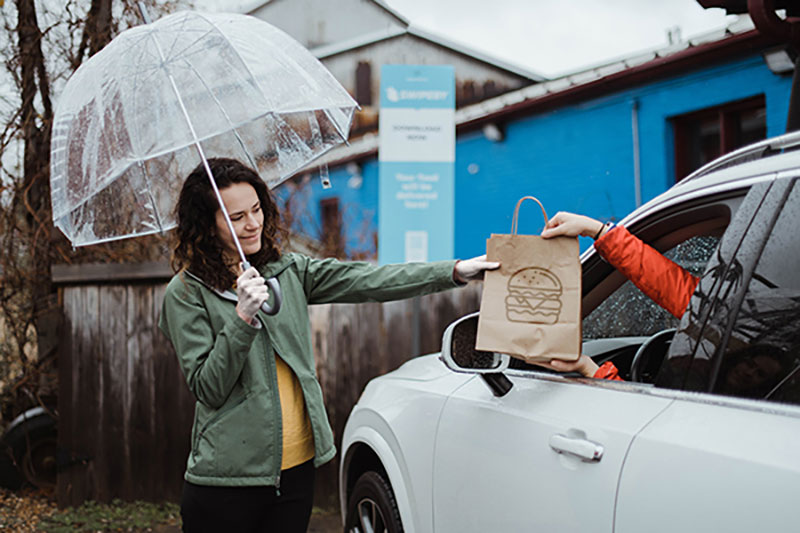Curbside pickup can resemble a modern game of telephone or a cell phone commercial with both parties essentially saying, “I’m here, can you see me?” Like many brands springing up to assist restaurants with this now-crucial ordering channel, Swipeby is looking to take manpower and uncertainty out of the arrangement to give restaurants an easier, less error-prone way to operate curbside at higher volumes.
Founded by a recent college grad who spent a semester at NYU Shanghai and became enamored with the plentiful, shockingly affordable restaurant delivery options, Swipeby Founder Carl Turner originally set out to create what he called “Tinder for food,” a more visual, sexier way for diners to explore nearby food options for in-store pickup.
While that idea didn’t gain the necessary traction, Turner saw an opportunity as mega-brands, including Walmart, Target and McDonald’s, moved heavily into click-and-collect business models. As issues on both on the restaurant and consumer sides with third-party delivery service fees became an increasingly hot topic, he pivoted to launch Swipeby, designed to give small brands the same customer-friendly option, but at much lower cost than other curbside providers on the market.
The questions that fueled Swipeby’s development included: “How can we turn any restaurant into a virtual drive-thru; how can we enable any restaurant from a small mom-and-pop to larger chains to offer that kind of Walmart click-and-collect experience, especially looking at suburban markets, not downtown New York City, but in markets where you have a lot of restaurants and people commute and drive.” “It took another year to fully build that out, and Swipeby launched in May 2019.”
Now exclusively focused on using mobile apps with geofencing to alert restaurant staff to approaching customers, Swipeby is being positioned as a turkey solution that can be turned on overnight to automate the entire process of calls and texts upon arrival, with technology to make it clear which order goes to which hungry driver in the lot.
For the back of the house, Swipeby automatically assigns demand and builds in prep times, so operations are smoothed on peak days, like Mother’s Day, where orders often far exceed typical volumes.
“Our system automatically learns and increases prep times based on demand level,” Turner added. “Our core focus is pickup, it’s on-premises, we are not planning to ever go into delivery, but we are building really cool products and features around that entire pickup experience.”
Having grown up in Germany, where much of his family still resides, Turner and his team had an inside track on the COVID-19 pandemic, which hit many European cities before crossing the pond to North America. With that advanced notice from relatives relaying the shutdowns they witnessed Turner knew this moment was a big opportunity for Swipeby—and a huge challenge for restaurants now relying almost entirely on off-premises volume that almost always brings additional costs to the profit-and-loss statement.
In response, the Swipeby team worked “literally day and night for three weeks” to make quick adjustments to the business model, which focused on making the on-boarding process more self serving, and lowering the North Carolina-based company’s overhead so it could charge its restaurant clients less.
“There are no sign-up costs—it’s completely waived and not deferred,” Turner said of the quick changes to the model. “We might bring it back when things normalize, but for now it’s completely free to sign up and I think we’re one of the only third-party services out there that has pricing public on our website.”
Those pricing details revolve around a 4.5 percent fee per order, with an additional 45 cents per transaction to cover Swipeby’s own costs. With such a newly lean model, Swipeby makes the bulk of its money on bundling credit card transactions from restaurants to negotiate a lower fee that provides revenue that’s, at present, sufficient for the company’s growing team of 15 employees.
For customers, no additional fees are charged, which Turner said means restaurants have no incentive to charge curbside customers any more than in-restaurant diners.
Harkening back to his college days, Turner said he was consistently frustrated with delivery providers, and specifically seeing a surprisingly high order total when all fees and additional charges are added to the bottom line.
Swipeby’s technology is tablet based, and not integrated with any point-of-sale systems. The company is “working on some of those integrations,” but stressed that its current technology is easy for staffers to use, reduces opportunities for human error and allows reduced manpower to ferry orders out to cars.
As it crossed the one-year mile marker, Swipeby is on boarding new restaurants quickly, including large-scale Virginia-based operator Performance Food Group, and expects to reach 1,000 restaurants on the platform within the next month or two.
Asked why the company is primarily focusing on suburban markets, Turner said there’s untapped demand in such markets—whether it’s suburban Dallas or Atlanta, as two examples—where the vast majority of residents commute exclusively in cars, rather than the public transport that’s more widespread in cities outside North America.
“In all of these markets, and especially looking in the U.S., there is no public transportation … so turning a restaurant into a virtual drive-thru, what we are doing with our technology end to end, makes any restaurant accessible to really capture the commuter market,” he said.




